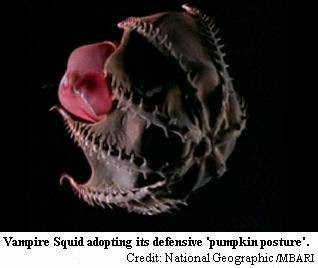Hmmm....... a guessing game. What am I?
A carnivorous plant?
A newly discovered exotic from the rainforest?
Night-blooming cactus? ????
Now, just imagine you are controlling an ROV, exploring the ocean depths. Down, down, down it sinks, to depths of 2,000 or even 3,000 feet. Suddenly, within view swims the most wondrous, Gothic-looking creature you have ever seen - Vampyroteuthis infernalis, which translated means "vampire squid from hell."
This diminutive marvel, reaching approximately 6 inches in length when full grown, is one of the ocean's most unique, well-adapted deep sea creatures.
Although commonly called the Vampire Squid, this cephalopod is neither a squid nor an octopus, although it shares common characteristics with both. The vampire squid is an ancient species, and is the only surviving member of the order Vampyromorphida.
When threatened, the vampire squid can flip its webbing completely over its body to protect itself from predators. This "pumpkin" or "pineapple" posture displays menacing-looking soft spines as well as protects and completely covers Vampyroteuthis' "real" eyes.
Light-emitting "decoy" eyes are also made visible to predators as a secondary defense mechanism. Vampyroteuthis is able to regulate the diameter of these "lights" - when closing them down, predators are left with the illusion that the intelligent creature has quickly fled to distances beyond their reach. If that also fails, Vampyroteuthis also has the ability to release a confusing cloud of bio-luminescent particles. These defenses, combined with its capability of swimming two of its body lengths per second, enable it to survive the deep ocean depths.
For amazing video footage of this rare and marvelous creature, click here.
Cool Creature Facts:
- Live at depths of between 300 - 3,000 feet
- Prefer temperatures between 35 - 43 degrees Fahrenheit
- Live and breathe normally in the oxygen minimum layer of the ocean where virtually no light penetrates
- Bodies are covered with light-producing organs called photophores
- Able to modulate the size and intensity of the photophores to create complex patterns to disorient predators and attract prey
- Large fins at the top of its body (resembling ears) are their primary means of propulsion
- Can also use jet propulsion to move by expelling water through a siphon jet located under the mantle
- Have a very gelatinous form resembling a jellyfish
- Have the largest eyes relative to body size of any animal; although only six inches in size, they have globular eyeballs about the size of a large dog
- Have eight arms which are connected with a webbing of skin
- Each arm is lined with single row of suction cups and rows of soft, fleshy spines knows as cirri
- Have one pair of retractable sensory filaments
- Have two ivory white, powerful beak-like jaws
- Color ranges from jet black to red
- Have a very low metabolic rate, enabling them to go for long periods of time without feeding














Very awesome, Catherine! So much beauty in the ocean ... a whole different world that I would love to be a part of and explore. However, I fear the water immensely! I am intrigued with all of its inhabitants though, as I had once wanted to be a marine biologist!
ReplyDelete